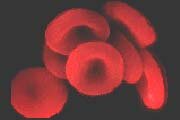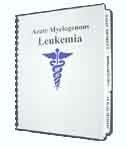 |
||
| HOME | ||
 |
||
| Acute Myelogenous Leukemia (AML) |
||
 |
||
| Other Leukemia Types (ALL / CLL / CML / HCL) |
||
 |
||
| Myelodysplastic Syndrome | ||
 |
||
| Symptoms and Diagnosis | ||
 |
||
| Leukemia Treatment Options | ||
 |
||
| " Chemotherapy | ||
 |
||
| " Blood Stem Cell Transplants | ||
 |
||
| " Radiation and Surgery | ||
 |
||
| " Chemo Side Effects | ||
 |
||
| " Clinical Trials Info | ||
 |
||
| " Coping with Leukemia | ||
 |
||
| " What to Ask Your Doctor | ||
 |
||
| Financial Assistance | ||
 |
||
| At Risk Jobs/Exposure | ||
 |
||
| Leukemia Resources | ||
 |
||
| Survivor's Story | ||
 |
||
| Leukemia News | ||
 |
||
|
Search for information:
|
||

|
Leukemia Cancer News - Return to Menu Medsaic Antibody Arrays Profile Leukemia By Renate Krelle (03/29/05)A company in Sydney, Australia, is hoping pathologists will be making room next to their flow cytometers for a new technology that provides doctors with a detailed profile of leukemias and lymphomas. Medsaic a University of Sydney spin-off is also aiming to use its microarray 'Dotscan' technology to work at the forefront of personalized medicine, using the disease profile results to determine the "right medicine for the right person at the right dose," according to company chairman Eric Tan. Dotscan is a microscope slide on which 82 different antibody dots are printed, specific for 82 leukemia cell surface antigens. White blood cells from a patient are dropped onto the array and incubated. Any cells expressing a particular antigen latch onto the corresponding anchored antibody on the slide. The Medsaic scanner then quantifies the intensity of the dots and produces a digital image. The resulting pattern can be analyzed and compared to that of known leukemia samples. The company has been testing the kit for about a year at several hospitals in Australia, as well as the MD Anderson Cancer Center in Houston, Texas. Currently, pathologists currently screen for leukemia by using techniques such as flow cytometry, which uses fluorescent probes to detect cell surface antigens. But they have drawbacks, requiring expensive reagents, experienced staff, and a relatively large amount of antibody. They also generally detect only 10 to 20 different cell surface antigens. Although skeptical at first, Professor Ken Bradstock, head of Blood & Marrow Transplant Services at Westmead Hospital, was finally won over by the Medsaic microarray. He says the technology represents the third big advance in diagnostics, following the development of monoclonal antibodies in the 1980s and the development of the flow cytometer in Silicon Valley in the 1990s. Tan explains that as the DotScan slide can be printed with up to 320 antibodies, the company also hopes to develop microarrays to "screen a whole lot of potentially efficacious antibodies by observing the degree of binding. If we can demonstrate that there is binding between the antibody and the cell, then there is evidence that the antibody is likely to work in the in vivo situation," he said. The potential advantage of this type of 'personalised medicine' will be to determine whether a patient is likely to respond to treatment particularly monoclonal antibody therapeutics. Diagnosis, Not Monitoring The most important aspect of the array would be its ability to shape the direction in which therapeutic antibodies are designed. "It will not do everything," says Medsaic CEO Jeremy Chrisp. "But it is cost-effective for rapid immuno-phenotyping of leukemias." Tan hopes the company will sell 4,000 units in the first year. Medsaic has appointed the Australian arm of Beckman Coulter to distribute the technology. International regulatory approval and sales are also planned. Medsaic also intends to extend its range of products to cover three market segments hematological malignancies, solid tissue tumors and autoimmune diseases. Enzyme activity promotes rare form of leukemia, offers potential target for new drugs 22 Apr 2005 - Scientists at the University of North Carolina at Chapel Hill have identified an enzyme that helps trigger the development of leukemia, a cancer of blood cells. The enzyme hDOT1L activates a set of genes that plays a key role in the rare and largely incurable acute myeloid leukemia (AML). This disease affects less than 2 percent of the estimated 16,000 individuals diagnosed with acute leukemia nationwide each year. The discovery, based on research using bone marrow cells from mice, offers a potential target for new drugs against this form of leukemia, the researchers said. The new findings appear in today's (April 21) issue of the journal Cell. The report demonstrates that hDOT1L helps transform, or immortalize, bone marrow cells, causing their unrestrained growth, a hallmark of leukemia, the researchers said. Dr. Yi Zhang, associate professor of biochemistry and biophysics at UNC's School of Medicine and a member of the UNC Lineberger Comprehensive Cancer Center, led the study. Zhang is the university's first Howard Hughes Medical Institute investigator, one of the most prestigious appointments among biomedical researchers. "We demonstrate that not only is hDOT1L required for transformation of bone marrow cells, but, more importantly, that its enzymatic activity is required to maintain the transformed status," said Zhang. "That means if we have a way to prevent the activity of hDOT1L, then the affected cells of particular leukemia patients can be killed." Zhang investigates a group of enzymes that modifies five core histone proteins forming the molecular scaffold that helps organize DNA within the nucleus of every cell. Histone modifications affect gene activity and include methylation, in which a methyl component is attached to the histone protein. "The prevailing model is that methylation on histones serves as a docking site," Zhang said. "It will recruit proteins that 'read' this histone modification, and it's those proteins that directly have an impact on gene expression - either activating or silencing a gene." As an enzyme that adds a methyl component to histone H3, hDOT1L activates the gene associated with that histone. Zhang and fellow researchers now provide evidence that in some leukemias, hDOT1L activates so-called Hox genes, whose increased activity is closely tied to AML. Leukemia most often arises from a chromosomal translocation, a breaking and joining of two distinct chromosomes, that creates a hybrid gene. The product of the hybrid gene is called a "fusion protein," meaning that the newly formed gene encodes a protein made of fragments from each of the two genes that were fused together by the rearrangement. Some leukemia patients carry rearrangements of a gene on chromosome 11 called the mixed lineage leukemia gene, or MLL. Translocations involving MLL are most often found in childhood leukemias and as a secondary cancer in adults who have undergone chemotherapy to treat a previous leukemia. Individuals with MLL translocations have an especially poor prognosis, with less than a 50 percent survival rate. "There are more than 40 proteins that have been found fused to MLL in leukemia patients, and different ones can cause leukemia by different mechanisms," Zhang said. When MLL functions as it should, without a fusion partner, it binds to and controls the expression of Hox genes, which in turn control cell growth and maturation. Until now, the role of the MLL-AF10 fusion protein in causing leukemia was unknown. "We show how at least one MLL fusion can lead to the over-expression of Hox genes in bone marrow cells. MLL-AF10 directs hDOT1L to the Hox genes, where it normally shouldn't be, causing a different pattern of histone methylation and, therefore, extraordinarily high activity of the Hox genes," Zhang said. Treatments used for AML patients have been largely ineffective against cells harboring the MLL-AF10 fusion protein, drawing attention to the need for a new medication. Zhang's study reveals that leukemia cells containing MLL-AF10 require hDOT1L to survive. When the researchers introduced into leukemia cells a defective form of hDOT1L, one that cannot methylate histone proteins, the cells were no longer able to grow. "This study highlights the potential of hDOT1L as a possible drug target," Zhang added. Co-authors on the study from Zhang's lab include postdoctoral fellow Dr. Yuki Okada and Dr. Qin Feng, a former graduate student. Also at UNC were Drs. Qi Jang and Vernon M. Coffield, both postdoctoral fellows in the lab of Dr. Lishan Su, associate professor of microbiology and immunology. Dr. Guoliang Xu, a professor at the Shanghai Institute of Biochemistry and Cell Biology, and his graduate students Yihui Lin and Yaqiang Li also contributed. The study was supported by a grant from the National Institutes of Health. By STUART SHUMWAY Note: Contact Zhang at (919) 966-3036 or [email protected]. School of Medicine contact: Les Lang, (919) 843-9687 or [email protected] Contact: L. H. Lang
|
|
|


